The Speech Intelligibility Devices Market is estimated to be valued at USD 2.3 billion in 2025 and is projected to reach USD 5.0 billion by 2035, registering a compound annual growth rate (CAGR) of 8.3% over the forecast period.
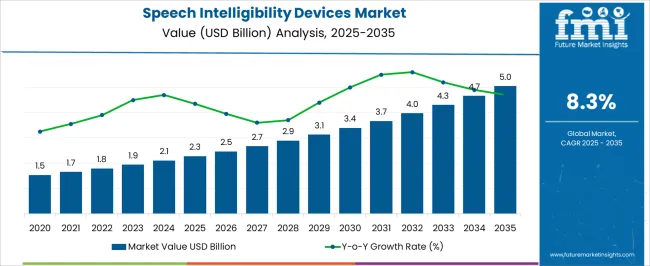
| Metric | Value |
|---|---|
| Speech Intelligibility Devices Market Estimated Value in (2025 E) | USD 2.3 billion |
| Speech Intelligibility Devices Market Forecast Value in (2035 F) | USD 5.0 billion |
| Forecast CAGR (2025 to 2035) | 8.3% |
The Speech Intelligibility Devices market is witnessing strong growth, driven by the rising demand for advanced communication technologies in healthcare, education, public safety, and professional settings. Increasing awareness of speech disorders and hearing impairments is leading to higher adoption of devices that enhance speech clarity and comprehension. Technological advancements in signal processing, noise reduction, and AI-based speech enhancement are improving device performance and user experience.
Integration with mobile and cloud platforms is enabling real-time monitoring, personalized configurations, and seamless user interaction. The growing emphasis on accessibility standards, regulatory compliance, and inclusive communication solutions is further shaping market adoption.
Institutions and organizations are increasingly deploying speech intelligibility devices to improve communication in classrooms, healthcare facilities, workplaces, and public spaces As awareness of speech clarity solutions continues to rise and investments in healthcare infrastructure and educational technologies expand, the market is expected to sustain long-term growth, with continuous innovation in software and hardware platforms enhancing usability, efficiency, and scalability.
The speech intelligibility devices market is segmented by sales channel, application, and geographic regions. By sales channel, speech intelligibility devices market is divided into Original Equipment Manufacturer and Aftermarket. In terms of application, speech intelligibility devices market is classified into Phonetics, Ethnical Factors, Acoustical Engineering, and Audiometry. Regionally, the speech intelligibility devices industry is classified into North America, Latin America, Western Europe, Eastern Europe, Balkan & Baltic Countries, Russia & Belarus, Central Asia, East Asia, South Asia & Pacific, and the Middle East & Africa.
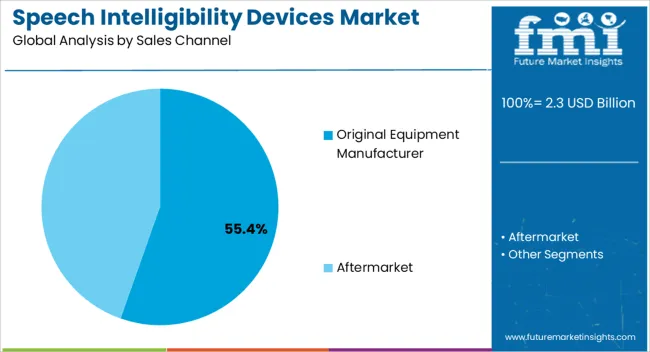
The original equipment manufacturer (OEM) sales channel segment is projected to hold 55.4% of the market revenue in 2025, establishing it as the leading channel. Growth in this segment is being driven by the preference of end-users for directly integrated solutions that offer reliability, quality assurance, and long-term support. OEMs provide devices with optimized design, compatibility with existing systems, and advanced signal processing features that enhance speech clarity.
Partnerships with healthcare institutions, educational organizations, and professional service providers further accelerate adoption. The ability to customize devices to meet specific client requirements and regulatory standards strengthens the market position of OEMs.
Technological integration, including AI-driven speech enhancement, cloud connectivity, and remote diagnostics, adds value to the OEM channel, increasing customer confidence and satisfaction As demand for high-performance, durable, and efficient speech intelligibility devices grows, the OEM sales channel is expected to remain the primary revenue contributor, supported by innovations in design, functionality, and user-centric solutions.
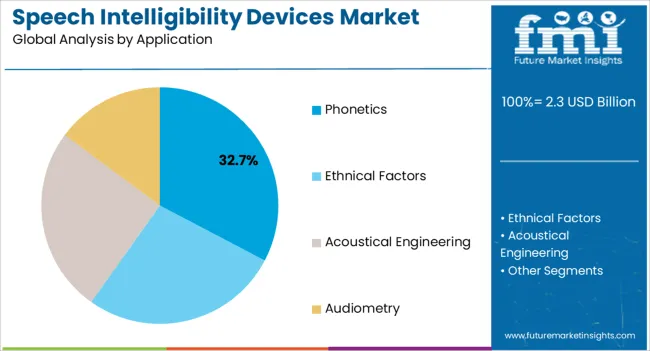
The phonetics application segment is anticipated to account for 32.7% of the market revenue in 2025, making it the leading application area. Growth in this segment is being driven by the increasing focus on improving speech clarity and pronunciation in clinical, educational, and professional settings. Speech intelligibility devices are being leveraged to support phonetic training, rehabilitation, and real-time speech enhancement, particularly for individuals with hearing impairments, speech disorders, or language learning needs.
Advances in audio signal processing, adaptive algorithms, and AI-powered speech analysis are enhancing device effectiveness, ensuring clear and accurate communication. The integration of phonetics-focused applications with educational tools, therapy programs, and training platforms is further supporting adoption.
Regulatory compliance in healthcare and education sectors, coupled with rising awareness of inclusive communication standards, has reinforced demand for phonetics-oriented devices As organizations and institutions continue to prioritize speech clarity and effective communication, the phonetics application segment is expected to remain a primary growth driver, supported by technological advancements and increased adoption across multiple sectors.
Speech is the basic mode of communication for humans, and hence it is of utmost importance that it is heard intelligibly. The intelligibility of speech relies upon the properties such as acoustical data in which the voice is transmitted from the speaker to the listener.
Furthermore, an important aspect of determining the speech intelligibility is the level of background noise.Even though there have been numerous efforts to factually quantify the speech intelligibility, the best method which is widely used is no doubt the Speech Transmission Index (STI) and its derivatives.
The speech transmission index is based on the relation between intensity modulations and perceived speech intelligibility in the speaker’s voice. The Modulation Transfer Function (MTF) defines to what amount the modulation is conveyed from the source to the receiver, as the modulation frequency varies from 0.63 to 12.5 Hz.
Thus, the modulation transfer function relies on the device properties and the noise produced in the background. Human communication is a continuous waveform with a fundamental frequency which varies from 100 to 400 Hz (The average is about 200 hertz for women and 100 hertz for men).
A recent research have come up with a development that the criminals and suspects of crimes can be identified through their recorded voice during that particular instant of crime with the use of speech intelligibility devices.
The voice modulation techniques have found application in investigation, defense as well as entertainment sectors. Since sound engineering is a hopeful sector in the field of science and technology, speech intelligibility gadgets will gain significant traction in the market over the forecast period.
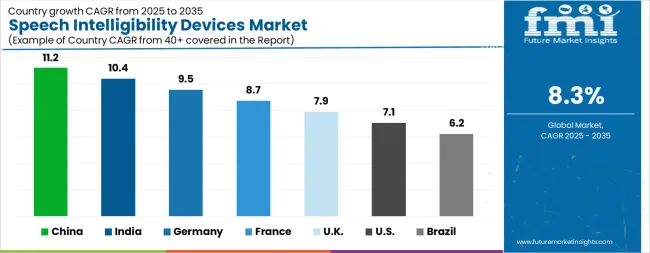
| Country | CAGR |
|---|---|
| China | 11.2% |
| India | 10.4% |
| Germany | 9.5% |
| France | 8.7% |
| UK | 7.9% |
| USA | 7.1% |
| Brazil | 6.2% |
The Speech Intelligibility Devices Market is expected to register a CAGR of 8.3% during the forecast period, exhibiting varied country level momentum. China leads with the highest CAGR of 11.2%, followed by India at 10.4%. Developed markets such as Germany, France, and the UK continue to expand steadily, while the USA is likely to grow at consistent rates. Brazil posts the lowest CAGR at 6.2%, yet still underscores a broadly positive trajectory for the global Speech Intelligibility Devices Market. In 2024, Germany held a dominant revenue in the Western Europe market and is expected to grow with a CAGR of 9.5%. The USA Speech Intelligibility Devices Market is estimated to be valued at USD 823.1 million in 2025 and is anticipated to reach a valuation of USD 1.6 billion by 2035. Sales are projected to rise at a CAGR of 7.1% over the forecast period between 2025 and 2035. While Japan and South Korea markets are estimated to be valued at USD 108.4 million and USD 73.2 million respectively in 2025.
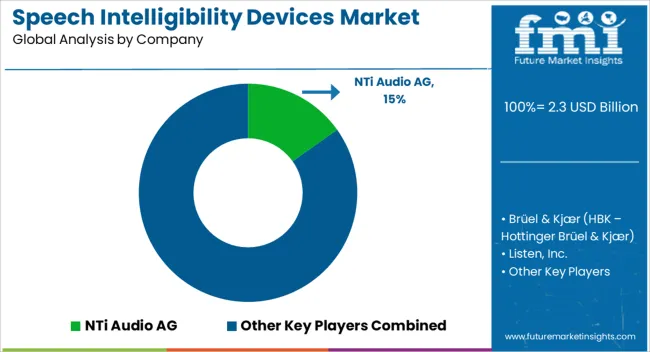
| Item | Value |
|---|---|
| Quantitative Units | USD 2.3 Billion |
| Sales Channel | Original Equipment Manufacturer and Aftermarket |
| Application | Phonetics, Ethnical Factors, Acoustical Engineering, and Audiometry |
| Regions Covered | North America, Europe, Asia-Pacific, Latin America, Middle East & Africa |
| Country Covered | United States, Canada, Germany, France, United Kingdom, China, Japan, India, Brazil, South Africa |
| Key Companies Profiled | NTi Audio AG, Brüel & Kjær (HBK – Hottinger Brüel & Kjær), Listen, Inc., Head Acoustics GmbH, Auditory Sciences, Larson Davis (PCB Piezotronics, Inc.), Aco Pacific, Inc., Etymotic Research, Inc., Rion Co., Ltd., BSWA Technology Co., Ltd., Cirrus Research plc, NTi Japan Co., Ltd., and Sinus Messtechnik GmbH |
The global speech intelligibility devices market is estimated to be valued at USD 2.3 billion in 2025.
The market size for the speech intelligibility devices market is projected to reach USD 5.0 billion by 2035.
The speech intelligibility devices market is expected to grow at a 8.3% CAGR between 2025 and 2035.
The key product types in speech intelligibility devices market are original equipment manufacturer and aftermarket.
In terms of application, phonetics segment to command 32.7% share in the speech intelligibility devices market in 2025.






Our Research Products

The "Full Research Suite" delivers actionable market intel, deep dives on markets or technologies, so clients act faster, cut risk, and unlock growth.

The Leaderboard benchmarks and ranks top vendors, classifying them as Established Leaders, Leading Challengers, or Disruptors & Challengers.

Locates where complements amplify value and substitutes erode it, forecasting net impact by horizon

We deliver granular, decision-grade intel: market sizing, 5-year forecasts, pricing, adoption, usage, revenue, and operational KPIs—plus competitor tracking, regulation, and value chains—across 60 countries broadly.

Spot the shifts before they hit your P&L. We track inflection points, adoption curves, pricing moves, and ecosystem plays to show where demand is heading, why it is changing, and what to do next across high-growth markets and disruptive tech

Real-time reads of user behavior. We track shifting priorities, perceptions of today’s and next-gen services, and provider experience, then pace how fast tech moves from trial to adoption, blending buyer, consumer, and channel inputs with social signals (#WhySwitch, #UX).

Partner with our analyst team to build a custom report designed around your business priorities. From analysing market trends to assessing competitors or crafting bespoke datasets, we tailor insights to your needs.
Supplier Intelligence
Discovery & Profiling
Capacity & Footprint
Performance & Risk
Compliance & Governance
Commercial Readiness
Who Supplies Whom
Scorecards & Shortlists
Playbooks & Docs
Category Intelligence
Definition & Scope
Demand & Use Cases
Cost Drivers
Market Structure
Supply Chain Map
Trade & Policy
Operating Norms
Deliverables
Buyer Intelligence
Account Basics
Spend & Scope
Procurement Model
Vendor Requirements
Terms & Policies
Entry Strategy
Pain Points & Triggers
Outputs
Pricing Analysis
Benchmarks
Trends
Should-Cost
Indexation
Landed Cost
Commercial Terms
Deliverables
Brand Analysis
Positioning & Value Prop
Share & Presence
Customer Evidence
Go-to-Market
Digital & Reputation
Compliance & Trust
KPIs & Gaps
Outputs
Full Research Suite comprises of:
Market outlook & trends analysis
Interviews & case studies
Strategic recommendations
Vendor profiles & capabilities analysis
5-year forecasts
8 regions and 60+ country-level data splits
Market segment data splits
12 months of continuous data updates
DELIVERED AS:
PDF EXCEL ONLINE
Speech Generating Devices Market
Speech and Voice Analytics Market Size and Share Forecast Outlook 2025 to 2035
Speech Analytics Market
EHR Speech Recognition Solution Market Size and Share Forecast Outlook 2025 to 2035
FBAR Devices Market
Snare devices Market
C-Arms Devices Market Size and Share Forecast Outlook 2025 to 2035
Timing Devices Market Analysis - Size, Growth, & Forecast Outlook 2025 to 2035
Spinal Devices Market Size and Share Forecast Outlook 2025 to 2035
Mobile Speech Recognition Software Market Size and Share Forecast Outlook 2025 to 2035
Hearing Devices 3D Printing Market Size and Share Forecast Outlook 2025 to 2035
Medical Devices Market Size and Share Forecast Outlook 2025 to 2035
Network Devices Market Size and Share Forecast Outlook 2025 to 2035
Medical Devices Secondary Packaging Market Analysis by Material and Application Through 2035
Hearable Devices Market Size and Share Forecast Outlook 2025 to 2035
Lab Chip Devices Market Size and Share Forecast Outlook 2025 to 2035
Orthotic Devices, Casts and Splints Market Size and Share Forecast Outlook 2025 to 2035
Lacrimal Devices Market Size, Trends, and Forecast 2025 to 2035
Global Ablation Devices Market Trends - Growth, Innovations & Forecast 2025 to 2035
Orthotic Devices, Splints & Orthopedic Braces Market Analysis - Trends & Forecast 2024 to 2034

Thank you!
You will receive an email from our Business Development Manager. Please be sure to check your SPAM/JUNK folder too.
Chat With
MaRIA